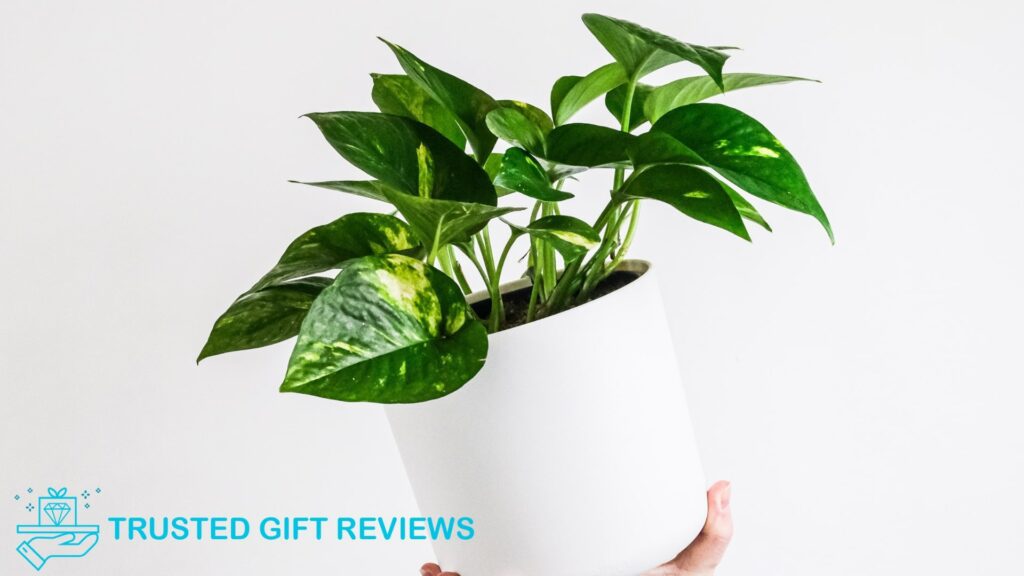Whether it’s a pot or hanging basket, the heart-shaped leaves of pothos plants can turn any indoor space into a lush haven. While they have hassle-free care requirements, one thing you have to master to unlock their true potential is finding the perfect soil mix.
Pothos plants thrive in a highly fertile, well-draining, well-aerated soil mix with good water-holding capacity. They produce greener and healthier leaves when grown in soil with a pH of 6.0 to 6.5.
In this guide, we’ll do a more in-depth discussion of the factors to consider when choosing a soil mix for your pothos, the components the soil mix should have, and the best recipes you can follow if you want to make your own soil mix.
Things to Consider When Choosing Soil for Pothos Plants
Good Drainage


When choosing or making a soil mix for your pothos plants, one of the most important characteristics you should look for is good drainage. It’s an essential property of a good soil mix that you can’t compromise.
Pothos plants have sensitive roots that can be prone to rotting if they’re consistently submerged in water. Well-draining soil prevents the roots from sitting in water for extended periods since water flows more freely.
Remember that pothos plants are relatively drought-tolerant, so you don’t have to worry about your soil drying out and killing your plant because of dehydration. Pothos plants are the type to prefer a relatively dry growing medium over a waterlogged one.
Aeration


Pothos plants, like many other plants out there, rely on oxygen to perform their usual physiological processes like photosynthesis. That’s why choosing a soil mix with plenty of air pockets where oxygen can penetrate and reach the roots is crucial.
Good aeration helps pothos develop stronger and healthier roots. This results in better absorption of nutrients and water and, subsequently, healthier pothos plants.
Moreover, good aeration can encourage beneficial bacteria and fungi to grow in the soil. These bacteria and fungi help break down organic matter in the soil, contributing to the overall fertility of the soil.
Moisture Retention


While pothos plants are drought-resistant, prolonged exposure to such growing conditions can take a toll on the plant’s health. That’s why you should look for a soil mix that can retain a good amount of moisture without being soggy.
Adequate moisture ensures that the plant is consistently hydrated, reducing the risk of water stress. If the soil has sufficient moisture, the plant can last longer without watering, which can be helpful when you’re busy and can’t water it.
Look for a soil mix that contains ingredients that can help retain moisture. Some ingredients you can look for are peat moss, coco coir, sphagnum moss, and horticultural charcoal.
Nutrient Content


One way to keep pothos plants lush and thriving is by providing them with a balanced amount of essential nutrients, nitrogen, phosphorus, and potassium. These nutrients are extremely necessary for the plant’s survival.
The soil’s nutrients will likely be depleted pretty fast while your pothos are growing, so make sure to choose a soil mix that’s rich in nutrients. Even with nutrient-rich mixes, you’ll still probably have to fertilize the soil every month.
You can add ingredients like compost, worm castings, manure, and mulch into your mix since they help improve soil fertility.
pH Level


If you want your pothos plant to reach its full potential, keep the soil’s pH level slightly acidic, preferably around the 6.0 to 6.5 range. Their roots develop best when grown in this range, as they can absorb nutrients better.
Extreme pH levels, either too acidic or too alkaline, can lead to nutrients becoming less available to the plant. Maintaining a slightly acidic pH helps prevent nutrient imbalance and helps pothos have better access to nutrients they need, like iron and manganese.
While pothos plants can generally adapt to neutral and slightly alkaline soils, exposing them to such conditions can be detrimental to their health. Monitor the soil’s pH regularly and adjust it accordingly.
Pot Type


While it’s not directly connected to the quality of the soil, it’s still important to consider the type of pot you’re using for your pothos when choosing a soil mix. The amount of drainage holes will help you determine how good the soil’s drainage will be.
Pots with only one drainage hole may require you to use a soil mix with better draining capacity than what you would use if it had three holes. You’ll also need to use soil with better moisture retention if you have a small pot since it tends to dry quickly.
Besides, the size and style of the pot, the material will also affect the type of soil you’ll use. Plastic pots are less porous than terracottas, so you’ll have to use a more porous soil mix.
Components of a Pothos Soil
Coco Coir


Coconut coir or coco coir is an eco-friendly product that can enhance aeration and moisture retention in the soil. It’s derived from coconut husks, which would have been considered a waste if not turned into coir.
Coco coir has a fibrous structure that helps create tiny channels within the soil where air can flow easily. Coir’s structure also helps it absorb moisture about 10 times its weight, which can help provide consistent hydration to plants.
It’s often used as a substitute for peat moss since it provides almost the same benefit while also being more eco-friendly. Coco coir can be a bit more expensive, though, and may be harder to find in certain areas, so you can just use peat moss if you have it.
Perlite
Perlite is a lightweight volcanic mineral that’s commonly used in gardening to make a porous and well-draining mix. It creates air pockets when added to soil, enhancing its draining capacity and reducing the risk of compaction.
It has excellent insulation, which can protect the roots during extremely hot summers and harsh winters. It’s also pH neutral, so it won’t have much effect on your soil mix’s pH level.
Perlite is typically reusable and can last for years. If you plan on reusing perlite, make sure to sterilize it by baking it in an oven.
Orchid Bark


Orchid bark is a popular growing medium for orchids, but it can also be used for other plants that love well-draining soil. It’s typically made from barks of different trees, including pine and fir.
The barks come in different sizes, but it’s usually best to use medium to large varieties for pothos plants. Larger barks provide better aeration and drainage in the soil since they create bigger air pockets.
Orchid bark also breaks down slowly, so your pothos can enjoy a stable growing medium for quite some time. You’ll generally only need to replace the soil mix and repot your pothos after one to two years.
Coarse Sand
Coarse sand has a much larger particle size than normal sand, allowing it to create a grittier texture in the soil mix. It’s often incorporated into the soil to create gaps between soil particles where water can move freely, thereby making the soil well-draining.
It can also help make the soil mix looser and crumblier, which makes it easier for the roots to penetrate.
When using coarse sand, make sure that it’s clean and free from contaminants. To be safe, choose those that are labeled “for horticultural use” or wash the sand thoroughly before use.
Worm Castings


Worm castings are produced by earthworms as they digest organic matter. They’re basically worm poop with a lot of nutrients.
They contain essential plant nutrients, including nitrogen, phosphorus, potassium, calcium, and magnesium. When added to the soil, they make these nutrients readily available for the plant.
Although they’re technically worm poop, they’re generally odorless, so they can be perfectly used for indoor plants. They’re also safe to handle, so they can be used for your houseplant even if you have kids and pets.
Horticultural Charcoal
Horticultural charcoal is a type of charcoal produced specifically for gardening use. It typically doesn’t contain chemicals, like argon and sodium nitrate, which normal charcoal has, making it more suitable for growing pothos plants.
It helps improve drainage and aeration while also enhancing the soil’s moisture retention properties. It’s large enough to create air pockets where excess water can pass through, but it also naturally has pores that can hold moisture.
It’s also widely believed that it can reduce the risk of plants being infected by fungi and pests. Activated charcoal tends to be a better choice for warding off pests, but it can be quite expensive, so many settle with horticultural charcoal.
Soil Mix Recipes for Pothos Plants


Recipe 1
- 5 parts orchid bark
- 4 parts coco coir
- 5 parts perlite
- 2 parts horticultural charcoal
- 2 parts worm castings
This recipe incorporates many ingredients that can make a soil mix with good moisture retention and nutrient content while also being well-draining and well-aerated. It’s a well-balanced recipe that’s usually best for bigger pothos plants.
Orchid bark and perlite help make a well-draining and well-aerated mix by creating huge air pockets. The rest of the ingredients can retain too much moisture, so perlite and orchid bark are added in 5 parts each.
Worm castings are rich in nutrients and can be an added organic matter in the plant. Horticultural charcoal can also protect the plants from pests like fungus gnats while improving the soil’s moisture retention capacity.
Recipe 2
- 4 parts coco coir
- 2 parts perlite
- 1 part coarse sand
- 1 part orchid bark
- 1 part worm castings
This is another well-suited mix for pothos, as it strikes a balance between moisture retention and drainage. It also has components that can improve the fertility of the mix.
Perlite, coarse sand, and orchid bark are added to provide better drainage and aeration, while coco coir is meant to help retain sufficient moisture to support the plant’s growth. Coir is added in 4 parts to balance the 3 components that address drainage.
One part of worm casting is enough to provide nutrients to support the initial growth of the plant. However, you might need to fertilize the plant at least every 4 weeks during the growing season to ensure it doesn’t suffer from nutrient deficiency.
Signs That Pothos Is in the Wrong Soil
Yellow Leaves
One of the possible reasons the leaves of your pothos are turning yellow is the wrong soil. The soil might not be draining well, or it doesn’t retain enough moisture for the plant.
When the soil doesn’t drain well, it leads to waterlogged conditions, which can suffocate the roots. When the roots are suffocated, they can’t uptake nutrients and perform normal metabolic processes, leading to yellow leaves.
Alternatively, if the soil isn’t retaining enough moisture, the plant becomes dehydrated, causing it to be stressed. This can affect the overall health of the plant, resulting in yellowing leaves.
Slow Growth
Pothos plants are naturally fast-growing, which is why a lot of homeowners love taking them in as houseplants. If your pothos is growing a lot slower than usual or it produces smaller leaves, the soil probably doesn’t have enough nutrients.
Pothos plants prefer heavily fertilized soils, so it’s important that the mix you’re using contains organic matter. Inadequate nutrients in the soil restrict root development, resulting in stunted growth.
Root Rot
Root rot is a common outcome of overly compacted and waterlogged soil. It’s a disease caused by fungi that grow in overly moist soil.
The fungi in the soil target the roots and cause them to decay. This impairs the plants’ ability to uptake nutrients, water, and air, making it hard for them to perform metabolic processes.
Common symptoms of this include dark, mushy roots and foul odor.




